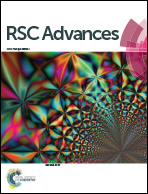Quinoxaline-functionalized C60 derivatives as electron acceptors in organic solar cells†
Abstract
Two novel C60 derivative acceptors (2,3-bis(5-tert-butylthiophen-2-yl)-6,7-dimethylquinoxaline-C60-monoadduct (TQMA) and 2,3-bis(5-tert-butylthiophen-2-yl)-6,7-dimethylquinoxaline-C60-bisadduct (TQBA)) with high LUMO levels have been synthesized and employed as model systems to study their interactions with donor poly(3-hexylthiophene) (P3HT) in bulk heterojunction organic solar cells (BHJ-OSCs). The optoelectronic, electrochemistry and the subsequent photovoltaic properties of these two acceptors have been fully investigated. Although the power conversion efficiency remains to be improved, BHJ-OSCs incorporating P3HT as donor and TQMA (or TQBA) as acceptor exhibit an open-circuit voltage (VOC) of 0.76 V (or 0.84 V), which is about 0.12 V (or 0.20 V) higher than PCBM as electron acceptor. The different photovoltaic performance among these acceptors can be rationalized by their different LUMO energies and molecular packing.


 Please wait while we load your content...
Please wait while we load your content...